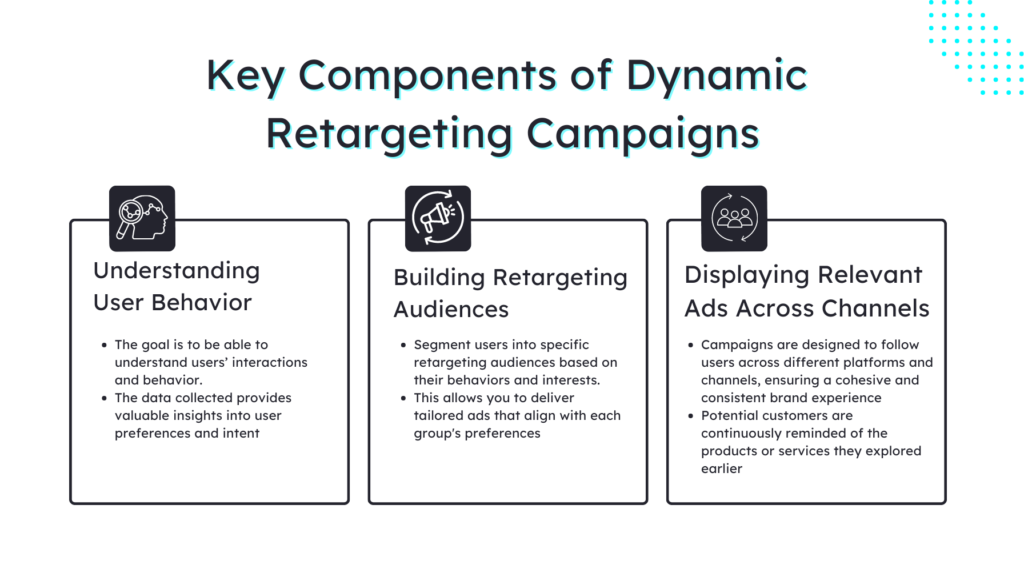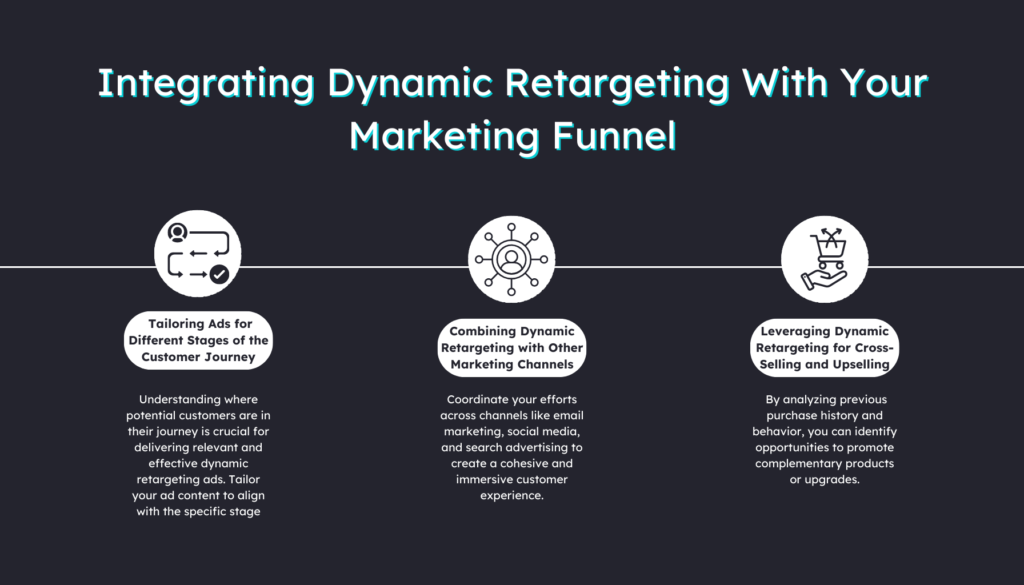
By offering personalized ad experiences tailored to individual user behavior, dynamic retargeting has revolutionized the way businesses connect with their audiences, driving higher conversion rates and fostering stronger customer relationships.
Dynamic retargeting, often referred to as personalized retargeting or remarketing, takes a customer-centric approach to advertising. It goes beyond the traditional one-size-fits-all approach of retargeting and delves into the realm of tailored experiences. By leveraging user data, such as their browsing history, previous interactions, and interests, dynamic retargeting delivers relevant and timely ads across various platforms and channels.
We’ll explore the world of dynamic retargeting and guide you through the process of implementing it to maximize your ROI.
Understanding Dynamic Retargeting: How Dynamic Retargeting Differs from Traditional Retargeting
Traditional retargeting involves displaying the same ad to all users who have previously visited a website or interacted with specific content. Regardless of their actions or preferences during their initial visit, users are exposed to a uniform message whenever they encounter retargeting ads across various platforms. While this approach can be useful to remind users about a brand or product, it lacks the personal touch needed to entice them to convert.
On the other hand, dynamic retargeting leverages user data to present personalized and highly relevant ads. Instead of showing generic ads, dynamic retargeting creates individualized ads based on users’ specific actions during their previous visits. This level of personalization significantly increases the chances of converting users into customers, as they are reminded of the exact products or services they showed interest in.
Key Components of Dynamic Retargeting Campaigns
- Understanding User Behavior:
At the heart of dynamic retargeting lies the identification of users. This has traditionally been done with cookies until Pathmonk Retargeting, a cookieless retargeting solution. The goal is to be able to understand users’ interactions and behavior, such as the products they viewed, items added to their cart, or pages they visited. The data collected provides valuable insights into user preferences and intent, enabling you to create personalized ad experiences.
- Building Retargeting Audiences:
With the help of the data collected, you can segment users into specific retargeting audiences based on their behaviors and interests. For instance, users who abandoned their shopping carts can be grouped together in a segment, while those who viewed a particular product but didn’t make a purchase can form another segment. These audience segments allow you to deliver tailored ads that align with each group’s preferences, maximizing the chances of conversion.
- Displaying Relevant Ads Across Channels:
Dynamic retargeting campaigns are designed to follow users across different platforms and channels they frequent, ensuring a cohesive and consistent brand experience. By displaying personalized ads on websites, social media platforms, search engines, and other online spaces, dynamic retargeting ensures that potential customers are continuously reminded of the products or services they explored earlier. This multi-channel approach increases brand visibility and keeps the brand fresh in the minds of users, even after they leave the initial website.

Benefits of Dynamic Retargeting Advertising
Dynamic retargeting offers a plethora of advantages that make it a valuable and indispensable tool in the modern marketer’s arsenal. Let’s explore the key benefits of implementing dynamic retargeting in your advertising strategy.
- Improved Conversion Rates and Sales:
One of the most significant advantages of dynamic retargeting is its ability to boost conversion rates and drive sales. By showing personalized ads featuring products or services that users have already expressed interest in, dynamic retargeting keeps your brand at the forefront of their minds during their decision-making process. This personalized approach nurtures potential customers and encourages them to return to your website to complete their purchase, significantly reducing cart abandonment rates. As a result, the chances of converting warm leads into loyal customers increase, translating into tangible improvements in your overall conversion rates and sales figures.
- Enhanced Customer Engagement and Brand Recall:
Dynamic retargeting campaigns create an engaging and personalized experience for users across different online platforms. By presenting them with ads that align with their interests and preferences, you establish a deeper connection with potential customers. The frequent exposure to relevant and tailored ads also strengthens brand recall, ensuring that users remember your brand long after their initial interaction with your website. This brand reinforcement plays a vital role in building brand loyalty and influencing users to choose your brand over competitors when they are ready to make a purchase.
- Optimized Ad Spend and ROI:
Dynamic retargeting enables you to allocate your advertising budget more efficiently. Since these campaigns target users who have already shown interest in your offerings, you are investing in warm leads with a higher likelihood of converting. As a result, you can optimize your ad spend by focusing on prospects who are more likely to engage and make a purchase, reducing wasteful spending on less interested audiences. The ability to deliver personalized ads also contributes to higher click-through rates and conversion rates, improving your return on investment (ROI) and delivering more value from your advertising budget.
Creating Effective Dynamic Retargeting Ads
Dynamic retargeting hinges on delivering personalized and relevant ad experiences to users based on their previous interactions. Crafting compelling dynamic ads requires a strategic blend of personalization, product showcasing, and real-time updates.
Personalization Strategies for Ad Copy and Imagery
Personalization is the cornerstone of successful dynamic ads. Tailor your ad copy and imagery to align with each user’s specific interests and preferences. Use language that speaks directly to their needs and incorporate dynamic elements such as countdown timers to create a sense of urgency or location-based information to provide localized offers. By making users feel like the ad was crafted just for them, you increase the likelihood of capturing their attention and driving engagement.
Showcasing Products or Services Users Engaged With
Highlighting the exact products or services that users previously viewed or added to their carts is a powerful way to reignite their interest. Dynamic retargeting enables you to display specific items, complete with their images, names, and prices, to remind users of their initial interest. Moreover, consider recommending related products that complement their previous choices or items that are frequently bought together. This strategic product showcasing enhances the user experience and increases the chances of converting their interest into a purchase.
Using Dynamic Elements for Real-Time Updates
Incorporating dynamic elements that update in real-time keeps your ads relevant and timely. Displaying live inventory levels, price changes, or limited-time offers encourages immediate action. For example, if a user added a product to their cart but didn’t complete the purchase, a dynamic ad could display the item along with a message like ‘Hurry, only 2 items left in stock!’ or ‘Special discount ends in 24 hours!’ These real-time updates capture users’ attention and prompt them to take action before missing out on a deal.
Pro Tip for Dynamic Retargeting Ads: A/B Testing and Iterative Improvement
As you create dynamic ads, consider conducting A/B tests to evaluate different elements’ performance. Test variations of ad copy, imagery, calls-to-action, and dynamic elements to identify the most effective combinations. Analyze the data and iterate your ad content accordingly to continually optimize your campaigns.

Integrating Dynamic Retargeting With Your Marketing Funnel
Dynamic retargeting can be a powerful addition to your marketing funnel, helping guide potential customers through different stages of the buyer’s journey. In this section, we’ll explore how to seamlessly integrate dynamic retargeting into your marketing funnel to maximize its impact on conversions and customer engagement.
1. Tailoring Ads for Different Stages of the Customer Journey:
Understanding where potential customers are in their journey is crucial for delivering relevant and effective dynamic retargeting ads. Tailor your ad content to align with the specific stage of the customer journey each audience segment is in:
Awareness Stage: For users who have recently visited your website or viewed your products, focus on brand recall, reinforce your unique selling points, and highlight value propositions. Use engaging visuals and persuasive copy to spark their interest and draw them back to your website.
Consideration Stage: Users who have engaged further, such as adding items to their cart or spending time exploring different product categories, are in the consideration stage. Deliver dynamic retargeting ads that showcase the products they showed interest in, along with compelling incentives like discounts, limited-time offers, or appropriate case studies.
Decision Stage: For users who have shown strong purchase intent, such as those who reached the checkout page but didn’t complete the transaction, create urgency-driven ads. Implement dynamic elements such as countdown timers or ROI calculators to encourage immediate action and reduce cart abandonment. Eradicate any doubt they could have in this final stage.
2. Combining Dynamic Retargeting with Other Marketing Channels:
Dynamic retargeting becomes even more potent when combined with other marketing channels. Coordinate your efforts across channels like email marketing, social media, and search advertising to create a cohesive and immersive customer experience. For example:
- Email Marketing: Use dynamic retargeting to reinforce email campaigns by displaying personalized ads featuring products or services users have shown interest in. This cross-channel approach keeps your brand top-of-mind and increases the chances of conversion.
- Social Media: Implement dynamic retargeting on social media platforms to re-engage users who have engaged with your brand on social media or visited your website. Use eye-catching visuals and compelling ad copy to capture their attention and drive them back to your site.
- Search Advertising: Leverage dynamic retargeting to show tailored ads to users who have searched for specific keywords or visited your website through search engine results. Delivering relevant ads in search results can significantly increase click-through rates and conversions.
3. Leveraging Dynamic Retargeting for Cross-Selling and Upselling:
Dynamic retargeting isn’t just about recapturing lost leads; it’s also a valuable tool for cross-selling and upselling to existing customers. By analyzing previous purchase history and behavior, you can identify opportunities to promote complementary products or upgrades. Create dynamic ads that showcase relevant add-ons or premium versions of products customers have already purchased, enticing them to explore additional offerings.
Implementing Dynamic Retargeting with Pathmonk Retargeting
Pathmonk Retargeting is an innovative cookieless solution that takes dynamic retargeting to the next level. By leveraging real-time intent data, Pathmonk Retargeting enables you to deliver highly personalized and dynamic ads across all advertising channels, maximizing the impact of their retargeting efforts.
2.5x better ad results with cookieless retargeting
Create high-converting retargeting ads based on your users' real-time intent.

Pathmonk Retargeting is the only software that enables marketers to get real-time intent data to understand user behavior and intent. Unlike traditional retargeting methods that rely solely on past actions, Pathmonk Retargeting takes into account a user’s current behavior on your website to determine their intent.
This data-driven approach allows you to target users at the precise moment when they are actively engaging with your content, increasing the chances of conversion.
Pathmonk Retargeting works across all ad platforms, including Meta, Google Ads, LinkedIn, Twitter, Pinterest, TikTok, etc. This ensures that users encounter a cohesive and compelling message, reinforcing your brand’s value proposition.
Overcoming Challenges of Retargeting Advertising
While dynamic retargeting offers significant benefits, it also presents some challenges that marketers must navigate to ensure the success of their campaigns. Let’s discuss key challenges faced during retargeting and provide strategies for overcoming them to maintain a high-performing dynamic retargeting strategy.
Dealing with Ad Fatigue and Frequency Capping
Ad fatigue occurs when users are repeatedly exposed to the same retargeting ads, leading to a decline in engagement and potential annoyance. To combat ad fatigue, implement frequency capping, which limits the number of times an individual sees the same ad within a specific time frame. This ensures that users do not feel overwhelmed by your ads and helps maintain their interest and receptiveness to your messaging.
Additionally, diversify your ad creatives and rotate them regularly to provide users with fresh content and avoid monotony.
Addressing Privacy Concerns and GDPR Compliance with Cookieless Retargeting
With growing concerns about user privacy and data protection, you must address privacy issues when implementing retargeting campaigns. The introduction of Pathmonk Retargeting, the only cookieless retargeting solution in the market, has become crucial in navigating the changing landscape of online advertising. Instead of relying on cookies, cookieless retargeting leverages an alternative technology known as a digital fingerprint to deliver personalized ads while respecting user privacy.
By adopting cookieless retargeting, you can comply with regulations like the General Data Protection Regulation (GDPR) and establish trust with users by prioritizing their data privacy. Additionally, providing clear and transparent information about data collection and usage in your privacy policy builds credibility and reassures users that their data is in safe hands.
Staying Competitive in an Evolving Digital Landscape
The digital advertising landscape is continually evolving, with new platforms, technologies, and consumer behavior trends emerging regularly. To stay competitive, keep a close eye on industry trends and advancements in retargeting technologies. Embrace innovation and be willing to experiment with new strategies to adapt to changing consumer preferences.
Leverage the power of data analytics to gain insights into the performance of your dynamic retargeting campaigns. Analyze key metrics, understand user behavior patterns, and identify areas for improvement. Use these insights to refine your retargeting strategies and make data-driven decisions that drive higher ROI.
Conclusion
Dynamic retargeting is a game-changing strategy that empowers you to engage potential customers with personalized and relevant ads throughout their buyer’s journey. By leveraging user data, implementing real-time intent-based retargeting with Pathmonk Retargeting, and tailoring ad content to match user behavior, you can create compelling ad experiences that drive higher conversion rates, increased sales, and enhanced brand recall.
Choosing the right retargeting platform or tools, integrating tracking pixels effectively, and creating audience segments based on user behavior are fundamental steps to ensure the successful implementation of dynamic retargeting campaigns. With a technical and data-driven approach, you can optimize your ad spend, minimize ad fatigue, and comply with privacy regulations.
Moreover, integrating dynamic retargeting into the marketing funnel allows for precise targeting at each stage of the customer journey. By delivering personalized ads that align with users’ interests and intent, you can nurture leads, encourage repeat purchases, and foster long-term customer loyalty.
Pathmonk Retargeting emerges as a cutting-edge solution that takes dynamic retargeting to new heights. Leveraging real-time intent data, Pathmonk enables you to deliver dynamic ads across all channels, precisely targeting users when they are most engaged. This innovative approach maximizes the impact of retargeting efforts and sets the stage for unparalleled results.





